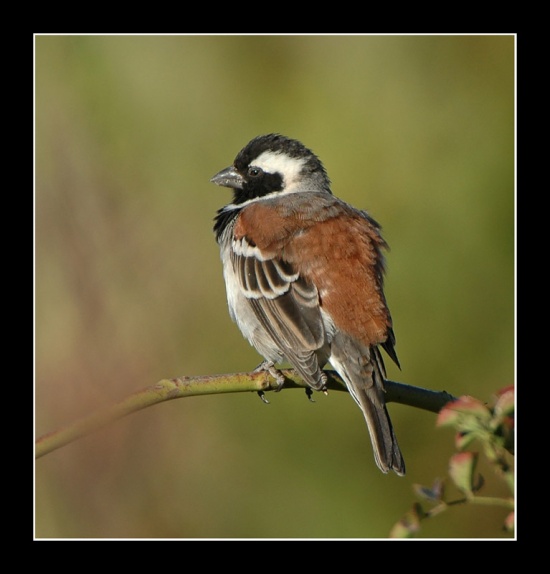m |
m (→External Links: Typo) |
||
| (6 intermediate revisions by 5 users not shown) | |||
| Line 1: | Line 1: | ||
| + | [[Image:Cape_Sparrow.jpg|thumb|550px|right|Male<br />Photo by {{user|Mybs|Mybs}}<br />Cedarberg Wilderness area, Western Cape, [[South Africa]], March 2005]] | ||
;[[:Category:Passer|Passer]] melanurus | ;[[:Category:Passer|Passer]] melanurus | ||
| − | |||
| − | |||
| − | |||
| − | |||
==Identification== | ==Identification== | ||
| − | Length 14-16 cm, mass 20-38 g. | + | Length 14-16 cm, mass 20-38 g.<br /> |
| − | + | '''Adult male''': Head black with broad white semicircles from behind eyes to side of throat. Nape and mantle greyish, merging into rufous or chestnut back and rump.<br /> | |
| − | '''Adult male''': Head black with broad white semicircles from behind eyes to side of throat. Nape and mantle greyish, merging into rufous or chestnut back and rump. | ||
| − | |||
'''Adult female''': Similar to the male, but with a grey and white head. | '''Adult female''': Similar to the male, but with a grey and white head. | ||
==Distribution== | ==Distribution== | ||
| − | [[South Africa]], [[Lesotho]], western [[ | + | [[South Africa]], [[Lesotho]], western [[eSwatini]], [[Botswana]], [[Namibia]], coastal south-western [[Angola]], south-western [[Zimbabwe]]. |
| + | |||
==Taxonomy== | ==Taxonomy== | ||
| + | [[Image:2007_09_11_Female_Cape_Sparrow.jpg|thumb|350px|right|Female<br />Photo by {{user|Alan+Manson|Alan Manson}}<br />Cedara Farm, Pietermaritzburg, [[South Africa]], September 2007]] | ||
''Passer melanurus'' has three subspecies: | ''Passer melanurus'' has three subspecies: | ||
*''P. m. melanurus'' from much of [[South Africa]]; | *''P. m. melanurus'' from much of [[South Africa]]; | ||
*''P. m. damarensis'' from [[Namibia]], [[Botswana]], neighbouring parts of [[South Africa]] and south-eastern [[Angola]]; and | *''P. m. damarensis'' from [[Namibia]], [[Botswana]], neighbouring parts of [[South Africa]] and south-eastern [[Angola]]; and | ||
| − | *''P. m. vicinus'' from [[Lesotho]], [[ | + | *''P. m. vicinus'' from [[Lesotho]], [[eSwatini]] and highlands of [[South Africa]]. |
| + | |||
==Habitat== | ==Habitat== | ||
The Cape Sparrow lives in dry areas of southern Africa like the arid and semi-arid savanna, dry woodland along drainage lines and seasonal watercourses; also croplands, plantations and copses of alien trees, parks and gardens. | The Cape Sparrow lives in dry areas of southern Africa like the arid and semi-arid savanna, dry woodland along drainage lines and seasonal watercourses; also croplands, plantations and copses of alien trees, parks and gardens. | ||
==Behaviour== | ==Behaviour== | ||
| − | ===Diet=== | + | ====Diet==== |
Forages mainly on the ground for seeds and insects, but also takes fruits, seeds and nectar directly from plants. | Forages mainly on the ground for seeds and insects, but also takes fruits, seeds and nectar directly from plants. | ||
| − | === | + | ====Breeding==== |
The Cape Sparrow nests singly, or in loose colonies (up to 100 pairs; up to 15 nests in one tree). The nest is an untidy mass of grass and other plant material with a tunnel entrance and is thickly lined with feathers or soft plant material. Laying usually August to March (2-6 eggs). | The Cape Sparrow nests singly, or in loose colonies (up to 100 pairs; up to 15 nests in one tree). The nest is an untidy mass of grass and other plant material with a tunnel entrance and is thickly lined with feathers or soft plant material. Laying usually August to March (2-6 eggs). | ||
==References== | ==References== | ||
| − | + | #{{Ref-Hockeyetal05}} | |
| + | {{ref}} | ||
==External Links== | ==External Links== | ||
| − | {{GSearch|Passer | + | {{GSearch|"Passer melanurus" {{!}} "Cape Sparrow" }} |
| + | {{GS-checked}}1 | ||
| + | <br /> | ||
| + | <br /> | ||
| + | |||
[[Category:Birds]] [[Category:Passer]] | [[Category:Birds]] [[Category:Passer]] | ||
Latest revision as of 20:19, 21 August 2023
- Passer melanurus
Identification
Length 14-16 cm, mass 20-38 g.
Adult male: Head black with broad white semicircles from behind eyes to side of throat. Nape and mantle greyish, merging into rufous or chestnut back and rump.
Adult female: Similar to the male, but with a grey and white head.
Distribution
South Africa, Lesotho, western eSwatini, Botswana, Namibia, coastal south-western Angola, south-western Zimbabwe.
Taxonomy
Passer melanurus has three subspecies:
- P. m. melanurus from much of South Africa;
- P. m. damarensis from Namibia, Botswana, neighbouring parts of South Africa and south-eastern Angola; and
- P. m. vicinus from Lesotho, eSwatini and highlands of South Africa.
Habitat
The Cape Sparrow lives in dry areas of southern Africa like the arid and semi-arid savanna, dry woodland along drainage lines and seasonal watercourses; also croplands, plantations and copses of alien trees, parks and gardens.
Behaviour
Diet
Forages mainly on the ground for seeds and insects, but also takes fruits, seeds and nectar directly from plants.
Breeding
The Cape Sparrow nests singly, or in loose colonies (up to 100 pairs; up to 15 nests in one tree). The nest is an untidy mass of grass and other plant material with a tunnel entrance and is thickly lined with feathers or soft plant material. Laying usually August to March (2-6 eggs).
References
- Hockey, PAR, WRJ Dean, and PG Ryan, eds. 2005. Roberts' Birds of Southern Africa. 7th ed. Cape Town: John Voelcker Bird Book Fund. ISBN 978-0620340533
Recommended Citation
- BirdForum Opus contributors. (2024) Cape Sparrow. In: BirdForum, the forum for wild birds and birding. Retrieved 18 April 2024 from https://www.birdforum.net/opus/Cape_Sparrow
External Links
GSearch checked for 2020 platform.1





